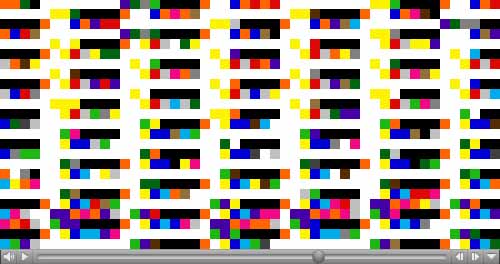View current page
...more recent posts

Above is a screen capture from Cory Arcangel's "Data Diaries," a series of Quicktime videos based on the raw memory lurking in his--and for all intents and purposes, everybody's--computer. Alex Galloway's text, excerpted below, describes the project eloquently:
Every so often an artist makes a work of art by doing almost nothing. No hours of torturous labor, no deep emotional expression, just a simple discovery and out it pops. What did Cory Arcangel do in this piece? Next to nothing. The computer did the work, and he just gave it a form. His discovery was this: take a huge data file--in this case his computer's memory file--and fool Quicktime into thinking it's a video file. Then press play. Your computer's memory is now video art. Quicktime plays right through, not knowing that the squiggles and shards on the screen are actually the bits and bytes of the computer's own brain. The data was always right in front of your nose. Now you can watch it.
[...]
Lots of artists talk about memory. But for artists working with computers, memory has a very specific technical definition. If ever computers had a subconscious, this is it. Cory describes it as "watching your computer suffocate and yell at the same time." They look like digital dreams--the pure shapes and tones of real computer memory. Each video documents a new day, and each day the computer offers us a new set of memories.
--Galloway/RSG
Looking at Arcangel's videos it's hard not to think of Jeremy Blake's better-publicized animations (thumbnail below right). The former is early House to the latter's late Synthpop--doing it more economically, energetically, and without all the gear. To continue the analogy, picture poor Blake, hunched over his screen plugging one color at a time into his designer grid, then giving it a tasteful blurry wash; when along comes the artist equivalent of Larry "Mr. Fingers" Heard, plugs in the visual equivalent of a cheap synth and drum machine, and rocks the house! Someone else doing it the hard way is Xose Salgado, an artist from Spain (?) I found surfing the net--his work looks similar to Arcangel's but is apparently carefully crafted from combinations of images viewed at low res.
The four-color map problem also comes to mind here. This was one of the great unsolved problems in mathematics, eventually cracked in the '70s with a "brute force" solution of letting a computer crunch numbers for days, as opposed to an elegant Occam's-razor theorem, which still doesn't exist. Paradoxically, Blake's way of working corresponds to the brute, time-intensive method, while Arcangel has invented a new technique that is both a means and an end: a kind of binary frottage that neatly bypasses off-the-shelf programming and shows us the beauty in a simple core dump.
